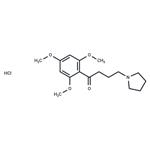Buflomedil hydrochloride is a vasoactive drug with a variety of actions. It is an alpha-adrenoceptor antagonist and a weak calcium channel blocker. It inhibits platelet aggregation and improves erythrocyte deformability. However, its mechanism of action in peripheral vascular disease is not known.
Buflomedil has generally been well tolerated by most patients in clinical trials. The most frequently reported adverse effects include flushing, headache, vertigo, gas-trointestinal discomfort, and dizziness. These rarely require drug withdrawal. In controlled trials, adverse effects have occurred in 20% of patients assigned to buflomedil and 18% of those assigned to placebo; only gastrointestinal discomfort occurred more frequently in buflomedil-treated patients (3.4 versus 2%)
Buflomedil is a non-selective antagonist of α-adrenergic receptors (α-ARs) and vasoactive compound.It binds to rat α1A- and α1B-ARs (Kis = 4.06 and 6.84 µM, respectively) and human platelet α2-ARs (IC50 = 1 µM) in radioligand binding assays.Buflomedil (0.06-60 µM) inhibits contraction of isolated canine saphenous veins induced by phenylephrine, clonidine, sympathetic nerve stimulation, or norepinephrine.It inhibits ADP-, collagen-, or epinephrine-induced aggregation of isolated human platelets when used at a concentration of 100 µM.Buflomedil (10 mg/kg) reduces hippocampal neuronal cell death in a rat model of carotid clamping-induced ischemia-reperfusion injury.
https://www.caymanchem.com
The target compound of buflomedil hydrochloride was synthesized from methyl 4-chlorobutyrate by condensation with pyrrolidine,then by hydrolysis,acylation,Fridel-crafts alkylation and salt formation.The structure of the target compound was confirmed by IR,1H-NMR and MS.The synthetic procedure is suitable for industrial production for the advantage of avaible materials,shorter routes,convenient operation and lower cost,the overall yield is improved from the reported 70% to 75.7%.
https://www.semanticscholar.org
Buflomedil is generally considered to be innocuous at therapeutic dosages. Acute toxicity is due to accidental or intentional overdosage. Overdosage causes generalized seizures and cardiac conduction abnormalities, eventually leading to cardiac arrest (SEDA-21, 215).
Meyler's Side Effects of Cardiovascular Drugs
Fonzylane,Lafon,France,1976
1-[3-(2,4,6-Trimethoxybenzoyl)propyl]pyrrolidinium chloride is used as an vasodilator (peripheral).
Introduce 33.6 g (0.2 mol) of 1,3,5-trimethoxybenzene and 100 ml of
chlorobenzene into a 500 ml three-neck flask with stirrer, hydrochloric acid
bubbler and condenser. Stir to dissolve and add 27.7 g of 4-
pyrrolidinobutyronitrile (from 4-chlorobutyronitrile and pyrrolidine). Cool to
about 15°-20°C and bubble hydrochloric acid gas in for 4 hours. Cool to about
5°C and add 200 cm3 of water. Stir. Decant the aqueous layer, wash again
with 150 cm3 of water. Combine the aqueous layers, drive off the traces of
chlorobenzene by distilling 150 cm3 of water, and heat under reflux for one
hour. Cool and render alkaline by means of 60 ml of sodium hydroxide
solution of 36° Baume. Extract twice with 100 ml of ether. Wash the ether
with 100 ml of water. Dry the ether over sodium sulfate and slowly run in 50
ml of 5N hydrogen chloride solution in ether, at the boil. Cool in ice. Filter,
wash with ether and dry in a vacuum oven. 33.6 g of crude product are
obtained. Recrystallize from 200 ml of isopropanol in the presence of 3 SA
carbon black. Filter. Wash and dry in a vacuum oven.
26.9 g of a white, crystalline water-soluble powder are obtained. Yield:
39.2%. Instantaneous melting point: 192°-193°C.



